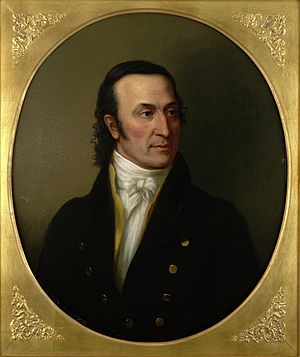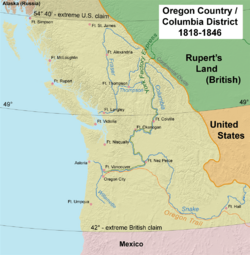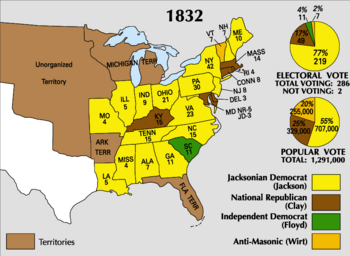John Floyd (Virginia politician) facts for kids
Quick facts for kids
John Floyd
|
|
|---|---|
 |
|
| 25th Governor of Virginia | |
| In office March 4, 1830 – March 31, 1834 |
|
| Preceded by | William Branch Giles |
| Succeeded by | Littleton Waller Tazewell |
| Member of the U.S. House of Representatives from Virginia's 20th district |
|
| In office March 4, 1823 – March 3, 1829 |
|
| Preceded by | Arthur Smith |
| Succeeded by | Robert Craig |
| Member of the U.S. House of Representatives from Virginia's 5th district |
|
| In office March 4, 1817 – March 4, 1823 |
|
| Preceded by | James Breckinridge |
| Succeeded by | John Randolph |
| Member of the Virginia House of Delegates from Montgomery County |
|
| In office October 10, 1814 – January 19, 1815 Serving with Thomas McHenry
|
|
| Preceded by | Thomas Goodson |
| Succeeded by | John Ingles |
| Personal details | |
| Born | April 24, 1783 Floyd's Station, Virginia, U.S. (now Jefferson County, Kentucky) |
| Died | August 17, 1837 (aged 54) near Sweet Springs, Virginia, U.S. (now West Virginia) |
| Political party | Democratic-Republican (Before 1828) Nullifier (1828–1829) Democratic (1829–1837) |
| Education | Dickinson College University of Pennsylvania (MD) |
| Signature |  |
| Military service | |
| Allegiance | |
| Branch/service | Virginia State Militia |
| Years of service | 1807–1814 |
| Rank | Brigadier General |
| Battles/wars | War of 1812 |
John Floyd (born April 24, 1783 – died August 17, 1837) was an important politician and soldier from Virginia. He served in the United States House of Representatives for Virginia. Later, he became the 25th Governor of Virginia.
While in the House of Representatives, John Floyd strongly believed the United States should claim the Oregon Country. He pushed for this idea from 1820 until he left Congress in 1829. However, the area didn't become a U.S. territory until 1848.
In the 1832 presidential election, John C. Calhoun chose Floyd to be the candidate for the Nullifier Party. The state of South Carolina gave all its eleven electoral votes to Floyd. During his time as governor of Virginia, a major slave rebellion led by Nat Turner happened. Even though Floyd supported states' rights (the idea that states should have more power), he also thought slavery should end slowly because it wasn't efficient. Virginia's economy grew stronger during his time as governor.
Contents
John Floyd's Early Life and Family
John Floyd was born in a place called Floyds Station, Virginia. This area is now near Louisville, Kentucky. His father, also named John Floyd, was a pioneer who died just before John was born. His mother was Jane Buchanan. John Floyd was also a cousin to Charles Floyd, who was the only person to die during the famous Lewis and Clark Expedition.
John Floyd learned at home and in a small schoolhouse. When he was thirteen, he went to Dickinson College in Carlisle, Pennsylvania. He had to leave college early because his family had money problems. Later, he moved to Philadelphia and studied medicine. He learned from a famous doctor named Benjamin Rush. In 1806, he graduated from the University of Pennsylvania with a medical degree. After that, he worked as a doctor in Virginia. He also served as a Justice of the Peace (a local official) in 1807.
In 1804, John Floyd married Letitia Preston. Her family was well-known in southwest Virginia. John and Letitia had twelve children. Some of their notable children included:
- John Buchanan Floyd, who later became a Governor of Virginia and a Secretary of War.
- Nicketti Buchanan Floyd, who married a U.S. Senator named John Warfield Johnston.
- George Rogers Clark Floyd, who was a Secretary of Wisconsin Territory.
John Floyd was a surgeon (doctor) in the Virginia State Militia from 1807 to 1812. He was a major. When the War of 1812 started, he joined the regular army. In 1814, he became a brigadier general in the Virginia militia. He served until he was elected to the Virginia House of Delegates later that year. During this time, his family moved to a large farm called Thorn Spring in Montgomery County, Virginia.
John Floyd's Political Career
From 1814 to 1815, John Floyd was a member of the Virginia House of Delegates. He was known for supporting a strong national government. He wanted Virginia to work closely with the U.S. government for defense. He also supported a bill that allowed Virginia to raise troops for the federal government.
In 1816, Floyd was elected to the United States House of Representatives as a Democratic-Republican. He served there from 1817 to 1829. He supported Henry Clay's idea to recognize Argentina's independence from Spain. Floyd believed this was important for America's own interests and freedom.
When General Andrew Jackson took action during the First Seminole War in Spanish Florida, some in Congress wanted to criticize him. But Floyd supported Jackson. He believed Jackson acted correctly based on his orders.
When Missouri wanted to become a state in 1820, there was a big debate about slavery. This led to the Missouri Compromise. Floyd didn't speak much about slavery itself. However, he strongly believed that states should have the right to decide their own rules. He felt that Congress shouldn't tell Missouri what to do about its constitution. He saw the states as independent nations that joined together for safety.
During the 1820 Presidential election, there was a question about whether Missouri's electoral votes should count. Floyd argued that they should. He and John Randolph caused a lot of debate. They believed Missouri should be allowed into the Union without problems.
Pushing for the Oregon Country
After the War of 1812, both Britain and the United States claimed the Oregon Country. John Floyd was the first person in Congress to seriously push for America to claim this land. On December 20, 1820, he asked Congress to look into settling the area. He wanted to explore the Columbia River region.
Floyd became the chairman of a committee to study this. In January 1821, he suggested a bill to allow the U.S. to take control of the Columbia River area. Nothing happened with this bill at first. Some people, like John Quincy Adams, thought Floyd was just trying to gain power.
Floyd kept trying. In 1821, he asked the Secretary of the Navy to estimate the cost of surveying harbors on the Pacific Coast. In 1822, he introduced a bill to make the area north of the 42nd parallel and west of the Rocky Mountains the "Territory of Oregon." He also tried to get information about the Treaty of Ghent, possibly to show that John Quincy Adams had not done enough for the West.
Floyd also used fears about Russia's claims in the area to gain support. He asked the president to share any foreign claims to the territory. This information was considered too sensitive to share.
In December 1822, President James Monroe agreed it was time to consider U.S. rights in Oregon. Floyd brought his bill back. He argued that the U.S. should take advantage of the rich trade opportunities with China and India that this area offered. He said this trade had been important for thousands of years.
His bill finally passed the House of Representatives with a vote of 115 to 57. However, it failed to pass in the Senate. Floyd continued to argue for settling Oregon for the rest of his time in Congress.
Role in Presidential Elections
Before the 1824 presidential election, William H. Crawford was a leading candidate. Some people accused Crawford of wrongdoing. A committee was formed to investigate, and John Floyd was its chairman. Even though Floyd supported Crawford, the committee found Crawford innocent.
The 1828 presidential election was a big one. Southern politicians wanted to remove President Adams from office. They eventually decided to support Andrew Jackson. Floyd worked hard to help Jackson win. He hoped to get a job in Jackson's new government, so he didn't run for Congress again. However, he did not receive a position.
Governor of Virginia
John Floyd served as Governor of Virginia from 1830 to 1834. During this time, he started to disagree with President Jackson. Jackson wasn't doing what Floyd and other Southern politicians wanted on issues like tariffs (taxes on imported goods).
In January 1831, Floyd was re-elected as governor for three more years. He was the first governor under Virginia's new state constitution from 1830. Virginia's economy was doing well under his leadership. He proposed a "bold economic program" to improve Virginia's economy. This included building roads and canals to help trade. He believed Virginia's future depended on who became president in 1832.
Floyd was different from other Southern leaders who opposed Jackson. While they feared the end of slavery, Floyd opposed slavery mainly for economic reasons. He thought it was not an efficient system.
The 1832 presidential election was coming. Floyd wanted Vice President John C. Calhoun to be the presidential candidate. He felt Calhoun had a better chance against Jackson than Henry Clay. Floyd, along with Littleton Waller Tazewell and John Tyler, were leaders of Virginians who were unhappy with Jackson. They felt Jackson had taken too much power.
In August 1831, the Nat Turner slave rebellion happened. In November, Floyd considered suggesting to the state assembly that slavery should be ended gradually. He thought this could happen for the whole state, or at least for the western counties first. However, he changed his mind before his official message. Instead, he encouraged other delegates to discuss it. The debate became very intense. Eastern delegates even talked about splitting the state. As a result, they voted on whether the state should make laws about this issue. The group that supported slavery won by a small margin.
During his address, Floyd also talked about national issues. He strongly supported the idea that states should have more power than the federal government. He believed the federal government was only an "agent of the States" and should only handle things that affected all states. He worried that the federal government was ignoring the states' concerns and taking too much power.
When the Democratic Party chose Martin Van Buren as their vice presidential candidate, Floyd was upset. He renewed his opposition to Jackson. Floyd believed Van Buren would bring "Northern principles" into the government. He thought this would lead to the quick end of slavery. Virginians tried to stop Van Buren from being elected. They suggested Philip P. Barbour as a running mate for Jackson. Floyd hoped this would make the Senate choose the vice president, where Van Buren might be stopped. However, Barbour later withdrew, and Van Buren became Vice President.
The Nullification Crisis was a big disagreement between South Carolina and the federal government. In December 1832, Jackson strongly opposed South Carolina's actions. However, in the 1832 presidential election, Jackson won re-election. Only South Carolina, which had its state legislature choose electors, gave all its eleven electoral votes to John Floyd for President.
Floyd was worried about a civil war. He called Jackson a "tyrant usurper." When he learned that Clay was willing to compromise on the tariff and that South Carolina would discuss its issues, he supported both ideas. The crisis was avoided. Floyd then tried to bring Clay and Calhoun together to form a new political party. This was the beginning of the Whig Party.
Floyd had a stroke in 1834 while still governor. He was able to finish his term. He asked Littleton Waller Tazewell to be his successor, and Tazewell won. On April 16, 1834, Floyd left Richmond for his home. He was escorted by several volunteer military companies.
Electoral history
- 1817; Floyd was elected to the U.S. House of Representatives with 57.6% of the vote. He defeated Federalist Elijah McClannahan.
- 1819; Floyd was re-elected without anyone running against him.
- 1821; Floyd was re-elected without anyone running against him.
Later Life and Death
In 1832, John Floyd's daughter, Letitia Floyd Lewis, converted to Catholicism. This caused a lot of discussion in Virginia. Later, other family members, including John Floyd himself, also converted after he left office as governor.
John Floyd died on August 17, 1837, after suffering a stroke. He passed away in Sweet Springs, which was then in Virginia but is now in West Virginia. His tombstone is in the Lewis Family Cemetery.
On January 15, 1831, the Virginia General Assembly created a new county called Floyd County. It was named after John Floyd, who was the governor at the time.
Images for kids



